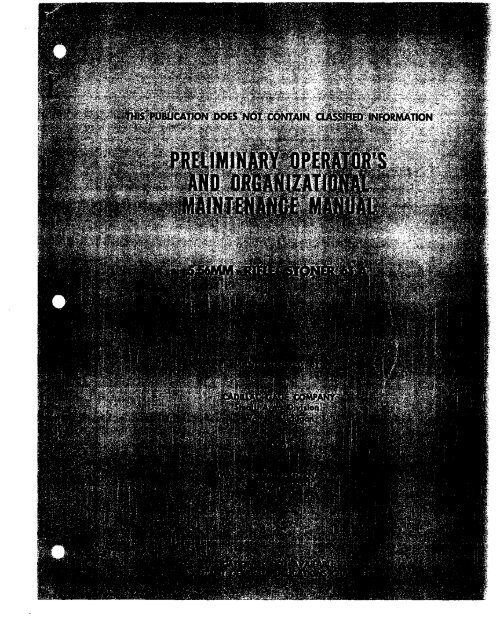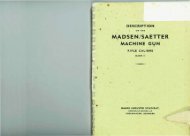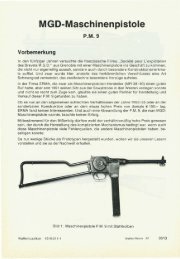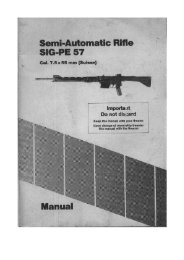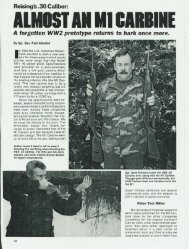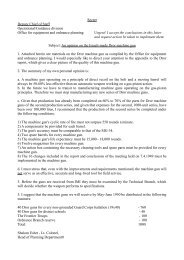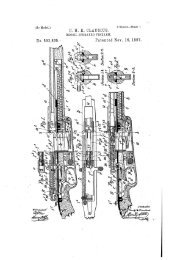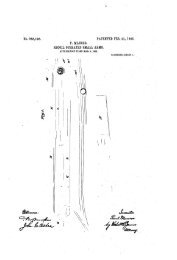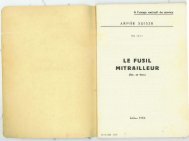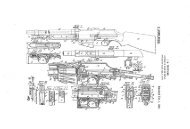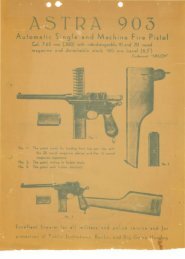Stoner 63A rifle manual.pdf - Forgotten Weapons
Stoner 63A rifle manual.pdf - Forgotten Weapons
Stoner 63A rifle manual.pdf - Forgotten Weapons
You also want an ePaper? Increase the reach of your titles
YUMPU automatically turns print PDFs into web optimized ePapers that Google loves.
• II.<br />
CHAPTER 1. INTRODUCTION<br />
TABLE OF CONTENTS<br />
Paragraph Page<br />
Section I. General ........•............................. 1<br />
CHAPTER<br />
II. Description and data . . . . . . . . . . . . . . . . . . . . . . . . . . . 2 2<br />
2. OPERATING INSTRUCTIONS<br />
Section I. Service upon receipt of materiel 5 5<br />
II. Controls . . . . . . . . . . . . . . . . . . .. . . . . . . . . . . . . . . . . . . 7 6<br />
III. Operation under usual conditions . . . . . . . . . . . . . . . . 10 10<br />
CHAPTER 3. ORGANIZATIONAL MAINTENANCE INSTRUCTIONS<br />
Section I. Repair parts, tools, and equipment . • . . . . . . . . . . . • 21 15<br />
Lubrication . . . . . . . . . . . . . .. . . . . . . . . . . . . . . . . . . . . . 2 4 16<br />
III. Preventive - maintenance services . . . . . . . . . . . . . . . 27 18<br />
N. Troubleshooting • . . . • • . . . . . • . • • . • . . . . . . • . • . . . • • 29 20<br />
V. Maintenance of Rifle . . . . . . . . . . . . . . . . . . . . . . . . . . . 31 23<br />
VI. Maintenance of blpod . • . . • . . . . • . • • . • . . . . . . . . . . . . 35 38<br />
APPENDIX I. BASIC ISSUE ITEMS<br />
Section I. Preface .....••.•••....•....• , ................ .. 39<br />
II. Basic Issue ....•............•.....••••......... 42<br />
APPENDIX II. ORGANIZATIONAL MAINTENANCE, REPAIR PARTS,<br />
AND SPECIAL TOOL LIST<br />
Section I. Preface ............................••.....•.... 44<br />
II. Repair parts and special tools •••••.....•.••••...• 45<br />
a
l. SCOPE<br />
CHAPTER 1<br />
INTRODUCTION<br />
Section I. GENERAL<br />
.9_. This <strong>manual</strong> contains instructions for operator and organizational mainten<br />
ance of the <strong>Stoner</strong> <strong>rifle</strong> and bipod.<br />
Q· Appendix I contains a list of basic issue items, repair parts, and tools and<br />
equipment which are required for operational maintenance of the weapon.<br />
£· Appendix II contains a list of repair parts, special tools and equipment<br />
which are required for performing organizational maintenance of the weapon.<br />
FIGURF I. STONER RIFLE LEFT AND RIGHT VIEW
2<br />
2. DESCRIPTION<br />
Section II. DESCRIPTION AND DATA<br />
_g_. The <strong>Stoner</strong> Rifle is a shoulder weapon. Detailed data are listed in paragraph<br />
5. It can be fired either automatically or semiautomatically by moving the<br />
selector lever to "SEMI" for semiautomatic or "AUTO" for automatic fire. Figure l<br />
shows the left and right side of the <strong>rifle</strong>.<br />
J::?.. The <strong>rifle</strong> has a dual range sight system for simplicity and reliability. Basic<br />
sight settings are fully adjustable in l minute of angle increments in windage and<br />
elevation. For ease in adjustment under field conditions the sights are readily adjusted<br />
by using the point of the 5 .56mm cartridge. At each incremental adjustment<br />
the sights are positively locked in place to prevent inadvertent misalignment. A<br />
bayonet and snap-on biped are provided for the <strong>rifle</strong> as shown in figure 2. The<br />
flash Sctppressor serves as a grenade launcher capable of launching <strong>rifle</strong> grenades<br />
presently in the system, as shown in figure 3. A conventional spring-loaded, 30round<br />
magazine feeds the ammunition to the <strong>rifle</strong>.<br />
FIGURE 2. STONER RIFLE - WITH BIPOD AND BAYONET
3 • NAME AND SERIAL NUMBER<br />
GRENADE<br />
SIGHT<br />
FIGURE 3, RIFLE GRENADE AND BIPOD ON RIFLE<br />
The name and serial number of the <strong>rifle</strong> are stamped on the top of the receiver in<br />
front of the rear sight (figure 6) •<br />
4, TABUlATED DATA<br />
h Weights in Pounds •<br />
Rifle (w/o magazine or sling) 7. 75 .lbs<br />
Empty Magazine 0 • 50 lbs (Steel)<br />
0 • 2 S lbs (Aluminum)<br />
Full Magazine (30 Rds ,) 1. 25 lbs (Steel Magazine)<br />
1. 00 lbs (Aluminum Magazine)<br />
Sling 0 .31lbs<br />
Cleaning Rod & Attachments 0. 25 lbs.<br />
Firing Weight (fully loaded with sling 9. 56 lbs (w/Steel Magazine)<br />
and magazine) 9. 3llbs (w/Aluminum Magazine)<br />
Bayonet Knife, M7<br />
Scabbard, M8Al<br />
Grenade Sight<br />
Biped<br />
Bipod Case<br />
0. 60 lbs<br />
0. 30 lbs<br />
0. 0 6 lbs<br />
0. 88 lbs<br />
0 .3llbs<br />
3
6<br />
7. GENERAL<br />
Section II. CONTROLS<br />
This section describes, locates, and illustrates the various controls provided<br />
for the operation and organizational maintenance of the <strong>rifle</strong> and bipod.<br />
8. RIFLE CONTROLS<br />
.£. Barrel Latch. The barrel latch (figure 4) is located on the bottom of the <strong>rifle</strong><br />
to the rear of the forearm grip. It consists of three parts, latch, lockpin and spring<br />
assembly. The lockpin is attached to the rear of the latch and locks and holds the<br />
barrel into posit ion .<br />
.Q. Bolt Stop. The bolt stop (figure 4) is located inside and at the rear of the ·magazine<br />
well. It holds the bolt and carrier in the open position when required by the<br />
operator or when the last round has been fired. To engage the bolt, pull the cocking<br />
handle to the rear and push up on the bolt stop. To release, pull back on the cocking<br />
handle or strike the butt sharply with the hand.<br />
g. Cocking Handle. The cocking handle (figure 5) is located on the top of the<br />
receiver. This control allows for <strong>manual</strong> cocking of the weapon when required .<br />
.Q.. Safety. The safety is located just forward of the trigger (figure 5). When<br />
pushed all the way forward through the slot in the trigger guard, the safety is in the<br />
"OFF" or FIRE" position. When pulled all the way to the rear, towards the trigger,<br />
it is in the "SAFE" position. This safety can be moved off safe without removing<br />
the trigger.finger from the trigger guard by pushing forward with the trigger finger.<br />
BOLT STOP<br />
BARREL LATCH SAFETY<br />
FIGURE 4. BARREL LATCH AND BOLT STOP
COCKING<br />
FIGURE 5. COCKING HANDLE, SELECTOR LEVER AND TRIGGER<br />
.!!.· Selector Lever. The selector lever (Figure 5) is located on the left side of<br />
the trigger housing group, above and to the rear of the trigger. It is movable to two<br />
positions, "SEMI" and "AUTO".<br />
f. Trigger. The trigger (Figure 5) is located below the receiver directly behind<br />
the feed way. Its function is to control the firing of the weapon with the selector<br />
lever in the SEMI or AUTO positions.<br />
g. Rear Sight.<br />
(l) The rear sight assembly (Figure 6) is located on top and to the rear of<br />
the receiver assembly and is held in place by two pins. The rear sight assembly<br />
provides short or long-range settings and windage adjustments. There are two<br />
apertures on an L-shaped sight. The short range aperture is used for short (0-300<br />
meter) ranges. The long range aperture is used for long (300-500 meter) ranges.<br />
The apertures are marked and identified "300" and "500", respectively.<br />
(2) The windage adjustment is located on the right side and to the rear<br />
of the rear sight assembly. Adjustments are made by inserting the point of a cartridge<br />
into the lower hole containing the plunger of the windage scale drum, and<br />
pushing in with the cartridge, rotating the drum in either direction. To move the<br />
point of impact of the bullet to the left, rotate the desired amount of increments<br />
in the direction of the arrow stamped "L" on the drum. Reverse the direction of<br />
rotation to move the impact of the bullet to the right. An index and scale are<br />
located at the base of the rear sight for correction reference.<br />
NOTE: Each graduation moves the bullet's point of impact one inch for every<br />
hundred meters of range, i.e., one inch at 100 meters, two inches at 200 meters,<br />
etc.<br />
7
10<br />
10. GENERAL<br />
Section III. OPERATION UNDER USUAL CONDITIONS<br />
This section contains instructions for the operation of the weapon under<br />
conditions of moderate temperatures and humidity.<br />
11. PREPARATION FOR FIRING<br />
_g. The <strong>rifle</strong> may be fired from the standing, kneeling, squatting, sitting,<br />
or prone position. When using the bipod, the bipod will be clamped to the front of<br />
the barrel (figure 10) .<br />
.Q. Check all ammunition to be sure it is the proper type and grade and that it is<br />
properly loaded into the magazine (figure 13) .<br />
9.· Check weapon to see if it has been thoroughly cleaned and lubricated. Inspect<br />
for malfu".ction or other defects.<br />
12. SERVICE BEFORE FIRING<br />
FIGURE 10. INSTALLATION OF BIPOD<br />
Perform the before-firing operations. (Refer to Table 2 .)
EMPTY LOADED<br />
MAGAZINE<br />
FIGURE 13. 30 ROUND MAGAZINES FIGURE 14. MAGAZINE<br />
SUPPORT AND lATCH<br />
12<br />
14, FIRING<br />
The <strong>rifle</strong> may be fired semiautomatically or automatically by moving the<br />
selector to the desired position.<br />
'!.· "SEMI" (Semiautomatic). With the selector lever in this position, the<br />
<strong>rifle</strong> will fire one round each time the trigger is pulled.<br />
----<br />
_Q_, "AUTO" (Automatic) • With the selector lever in this position, the <strong>rifle</strong> will<br />
continue to fire until the magazine is exhausted or trigger is released.<br />
15. MISFIRE, HANG FIRE, AND COOKOFF<br />
\!.· Misfire. A misfire is a complete failure to fire. A misfire in itself is<br />
not dangerous but, since it cannot be immediately distinguished from a delay in<br />
the functioning of the firing mechanism or from a hangfire {Q_below), it should<br />
be considered as a possible delayed firing until such possibility has been<br />
eliminated. Such a delay for example, could result from the presence of grit,<br />
sand, frost, ice, or improper or excessive oil or grease which might create a<br />
partial mechanical restraint which, after some indeterminate delay, is overcome<br />
and the firing pin is then driven into the primer in the normal manner. In this<br />
connection, no round should be left in a hot weapon any longer than the circumstances<br />
require because of the possibility of a cookoff (Q below) • Refer to<br />
paragraph 19 for removal procedures.
Q.. Hangfire. A hangfire is a delay in the functioning of a propelling charge at<br />
the time of firing. The amount of delay is unpredictable but, in most cases, will<br />
fall within the range of a split second to several minutes. Thus, a hang fire cannot<br />
be distinguished immediately from a misfire and therein lies the principal danger of<br />
assuming a failure of the weapon to fire immediately upon actuation of the firing<br />
mechanism is a misfire, whereas, in fact, it may prove to be a hangfire.<br />
WARNING: During the prescribed time intervals, the weapon will be kept trained<br />
on the target. All personnel will stand clear of the muzzle. Refer to paragraph 16<br />
for removal procedures.<br />
Q. Cookoff. A cookoff is a functioning of any or all of the explosive components<br />
of a round chambered in a very hot weapon due to the heat of the weapon. If the primer<br />
or propelling charger should cookoff, the projectile may be propelled from the<br />
weapon with normal velocity even though no attempt was made to fire the primer by<br />
actuating the firing mechanism. In such a case, although there may be uncertainty<br />
as to whether or when the round will fire, the precautions to be observed are the<br />
same as those prescribed for a hangfire (!2 above) • To prevent a cookoff, a round<br />
which has been loaded into a very hot weapon should be fired or removed within 5<br />
seconds. Refer to the following paragraphs for removal procedures.<br />
16. PROCEDURES FOR REMOVING A ROUND IN CASE OF FAILURE TO FIRE<br />
.9_, General, After a failure to fire, due to the possibility of a hangfire or cookoff,<br />
the following general precautions, as applicable, will be observed until the round<br />
has been removed from the weapon and the cause of failure determined.<br />
(1) Keep the weapon trained down range. All personnel will stand<br />
clear of the muzzle.<br />
(2) Before retracting the bolt, either to remove the round or recook as the<br />
case may be, personnel not required for the operation will be cleared<br />
from the vicinity.<br />
(3) The round, after removal from the weapon, will be kept separate from<br />
the other rounds until it has been determined whether the round or the<br />
firing mechanism was at fault. If it is determined that the round is at<br />
fault, it will continue to be kept separated from the other rounds until<br />
disposed of, On the other hand, if examination reveals that the firing<br />
mechanism was at fault, the round may be reloaded and fired after correction<br />
of the cause for failure to fire.<br />
Q. Time Interval. The definite time intervals for waiting after failure of weapon<br />
to fire are prescribed as follows: Always keep the round locked in the chamber for<br />
5 seconds from the time a misfire occurs, to in sure against an explosion outside of<br />
the weapon in the event a hangfire develops, If the barrel is hot and a misfire stops<br />
automatic operation of the weapon, wait 5 seconds with the round locked in the<br />
chamber to insure against hangfire dangers, then extract immediately to prevent a<br />
cook off. If the round cannot be extracted within 10 seconds, it must remain locked<br />
in the chamber for at least 5 minutes due to the possibility of a cookoff.<br />
13
14<br />
WARNING: Do not retract the bolt when a hangfire or cookoff is suspected .<br />
A hangfire will normally occur within 5 seconds from the time the primer is struck and<br />
a cookoff after 10 seconds of contact with the chamber in a hot barrel. One hundredfifty<br />
rounds fired in a 2-minute period will make a barrel hot enough to produce a<br />
cookoff.<br />
17. DOUBLE FEED<br />
A double feed is malfunction which occurs when the empty case fails to eject and<br />
another round is picked up by the bolt. Neither can feed or chamber properly and<br />
both become jammed and deformed. Both rounds can be ejected <strong>manual</strong>ly using the<br />
cocking handle. The cause normally is a short recoil which indicates a dirty gas<br />
cylinder or faulty ammunition.<br />
18. SERVICE DURING FIRING<br />
No during-firing service operations are required for this weapon.<br />
19. UNLOADING<br />
To unload a cocked, loaded <strong>rifle</strong> use the following procedures:<br />
.E.· Move the safety lever to (Safe) position. (all the way to the rear)<br />
£. Remove the magazine from the weapon.<br />
£· Move cocking handle to the full rearward position and eject the ammunition<br />
in the firing chamber.<br />
,9AUTION: Do not attempt to clear <strong>rifle</strong> without <strong>manual</strong>ly holding cocking<br />
handle in the fully open posit ion.<br />
g. Holding the cocking handle in the fully open position, insert index finger<br />
into the magazine well and push bolt stop upward. Gradually release the <strong>manual</strong> pressure<br />
on the cocking handle, allowing the bolt to rest against the bolt stop. Keep<br />
<strong>manual</strong> pressure on the cocking handle .<br />
.§.. Look through the ejection port and into firing chamber to make sure the chamber<br />
is clear of ammunition.<br />
20. SERVICE AFTER FIRING<br />
Perform the after-firing operations. (Refer to table 2 .)
21. GENERAL<br />
CHAPTER 3<br />
ORGANIZATIONAL MAINTENANCE INSTRUCTIONS<br />
Section I. REPAIR PARTS, TOOLS, AND EQUIPMENT<br />
Repair parts, tools, and equipment are issued to the using organization for operating<br />
and maintaining the materiel. Tools and equipment should not be used for<br />
purposes other than prescribed and, when not in use, should be properly stowed.<br />
22. REPAIR PARTS<br />
Repair parts are supplied to the using organization for replacement of those parts<br />
most likely to become worn, broken, or otherwise unserviceable, when replacement<br />
of these parts is authorized to the using organization. Repair parts supplied to the<br />
using organization are listed in Appendix I, which is the authority for requisitioning<br />
replacements. Repair parts supplied for organizational maintenance are listed in<br />
Appendix II.<br />
23. SPECIAL TOOLS AND EQUIPMENT<br />
Special tools are listed in Appendix I.<br />
15
25. GENERAL LUBRICATION INSTRUCTIONS<br />
.§.· Usual Conditions. Lubrication intervals specified in Table 7, are for<br />
normal operation and where moderate temperature and humidity prevail.<br />
.Q.. Reports and Records. Report unsatisfactory performance of materiel or<br />
effect of prescribed lubricants and preserving materials.<br />
26. SPECIFIC LUBRICATION INSTRUCTIONS<br />
.§_. General. Lubrication will be performed more frequently than specified<br />
in table to compensate for abnormal operation and extreme conditions, such as high<br />
or low temperatures, prolonged periods of high-rate operation, or continued exposure<br />
to moisture, any one of which may quickly destroy the protective qualities of<br />
the lubricant •<br />
.Q.. Changing Grade of Lubricants. Lubricants are prescribed in accordance<br />
with temperature ranges: above 0°F., and below 0°F. The time to change the grade<br />
of lubricants is determined by maintaining a close check of the operation of the weapon<br />
during the approach to changeover periods in accordance with weather forecast<br />
data. Ordinarily, it will be necessary to change grade of lubricants only when air<br />
temperature is consistently above or below 0°F.<br />
g. Extreme Cold Weather. Apply a light coat of weapons lubricating oil (LAW)<br />
to all operating mechanism surfaces. Materiel should be exercised more frequently<br />
during the periods of low temperature to insure proper functioning.<br />
Q• Extreme Hot Weather. Special lubricants will ordinarily not be required at<br />
extremely high temperatures, as lubricants prescribed for temperatures above 0°F.<br />
provide adequate protection. However, more frequent servicing than specified in<br />
Tables 2 and 3 is necessary because the heat tends to dissipate the lubricants .<br />
.§.. Humid and Salt-Air Conditions. High humidity, moisture, or salt air contaminate<br />
lubricants, necessitating more frequent service than specified in Tables<br />
2 and 3.<br />
%_. Before Immersion. Lubricate materiel before amphibious operation as prescribed<br />
in Table 3.<br />
g_. After Immersion. After immersion, perform the maintenance described in<br />
paragraph 27, which covers maintenance operations after immersion and includes<br />
special lubrication instructions.<br />
h· Sandy or Dusty Conditions. If firing or prolonged travel has occurred under<br />
dusty or sandy conditions, olean and inspect all lubricated surfaces for fouled lubricants.<br />
Lubricate as necessary.<br />
17
28. PREVENTIVE MAINTENANCE BY ORGANIZATIONAL MAINTENANCE PERSONNEL<br />
Refer to Table 3 .<br />
Sequence<br />
No,<br />
1<br />
2<br />
3<br />
4<br />
5<br />
6<br />
7<br />
Table 3. WEEKLY PREVENTIVE-MAINTENANCE SERVICES<br />
ORGANIZATIONAL MAINTENANCE PERSONNEL<br />
Item Procedure<br />
Barrel Assy Check for unusual wear and damage to bore.<br />
Barrel Assy Check for evidence of metal fouling.<br />
corrosion, and use of unauthorized<br />
cleaning material and methods .<br />
Inertia Pin Check to determine if the inertia pin has<br />
free movement inside the gas piston.<br />
Action parts Check for smoothness of operation.<br />
Visually examine moving parts for unusual<br />
wear.<br />
Action parts Check for corrosion and damage.<br />
Lubrication See that all items have been lubricated<br />
as prescribed in Table 1.<br />
Equipment See that tools and equipment are serviceable,<br />
cleaned, and properly stowed.<br />
19
20<br />
29. SCOPE<br />
Section IV. TROUBLESHOOTING<br />
This section contains troubleshooting information and tests for locating and<br />
correcting some of the troubles which may develop in the weapon. Troubleshooting<br />
is the systematic study of trouble signs, testing to determine the defective component,<br />
and applying corrective action. Each malfunction is followed by probable<br />
causes and suggested procedures to be followed.<br />
30. TROUBLESHOOTING GUIDE<br />
Table 4 is intended to be used only as a guide in troubleshooting. This table<br />
does not cover all possible malfunctions that may occur; only the more common malfunctions<br />
are listed. The tests and corrective actions are governed by the scope of<br />
the operator or organizational level of maintenance.<br />
Table 4. TROUBLESHOOTING<br />
Malfunction Probable Cause Corrective Action<br />
Bolt fails to look to l. Faulty Magazine. 1. Replace Magazine.<br />
the rear after the last 2. Broken bolt stop 2. Refer to higher<br />
round. and/ or spring. echelon (direct<br />
support) for corrective<br />
action.<br />
Failure to feed. l. Faulty Magazine. 1. Replace Magazine.<br />
2. Dirty or car boned gas port. 2. Clean.<br />
3. Lubrication inadequate. 3. Apply lubricant as<br />
required.<br />
4. Damaged or weak driving 4. Refer to higher<br />
spring. echelon (direct<br />
support) for correchve<br />
action.<br />
Failure to cycle when l. Frozen ejector. l. Disassemble and clean.<br />
set on "AUTO". 2. Insufficient gas. 2. Clean gas cylinder.<br />
3 • Broken timer assy. 3. Refer to higher echelon<br />
(direct support)<br />
for corrective action.<br />
4. Faulty selector lever. 4. Refer to higher echelon<br />
(direct support)<br />
for corrective action.
Table 4. TROUBLESHOOTING - Continued<br />
Malfunction Probable Cause Corrective Action<br />
Failure to fire. 1. Improperly installed l. Disassemble and<br />
hammer or trigger spring. install properly.<br />
2. Faulty ammunition. 2. Remove and replace<br />
ammunition .<br />
3. Broken or damaged 3. Refer to higher echfiring<br />
pin. elon (direct support)<br />
for corrective action.<br />
4. Dirty chamber. 4. Clear and clean.<br />
5. Broken hammer spring. 5. Refer to higher echelon<br />
(direct support)<br />
for corrective action.<br />
6. Broken timer assembly. 6. Refer to higher echelon<br />
(direct support)<br />
for corrective action.<br />
7. Misalined or worn trigger 7. Refer to higher echor<br />
hammer spring. elan (direct sup port)<br />
for corrective action.<br />
Failure to extract. l. Broken extractor spring. 1. Refer to higher echelon<br />
(direct support)<br />
for corrective action.<br />
2. Broken extractor. 2. Refer to higher echelon<br />
(direct support)<br />
for corrective action.<br />
3. Short recoil • 3. Clean gas cylinder.<br />
Failure to chamber. 1. Ruptured cartridge case. 1. Remove.<br />
2. Damaged round. 2. Recharge weapon.<br />
Failure to eject. 1. Short recoil. 1. Clean gas cylinder.<br />
2. Frozen ejector. 2. Remove and clean.<br />
3. Damaged ejector. 3. Refer to higher echelon<br />
(direct support)<br />
for corrective action.<br />
Fires with safety on l. Faulty safety. 1. Refer to higher echsafe<br />
position. elon (direct support)<br />
for corrective action.<br />
2. Broken trigger. 2. Refer to higher echelon<br />
(direct support)<br />
for corrective action.<br />
21
22<br />
Malfunction<br />
With selector lever on<br />
"SEMI", fires when<br />
trigger is released.<br />
Table 4. TROUBLESHOOTING - Continued<br />
Probable Cause<br />
1. Faulty hammer or trigger.<br />
With selector lever on<br />
"SEMI", fires automati- 1. Faulty disconnect spring.<br />
cally.<br />
2. Faulty disconnect.<br />
3. Faulty selector lever.<br />
Bolt seizes, will not 1. Carbon dirty or burred<br />
rotate. bolt group.<br />
Corrective Action<br />
1. Refer to higher echelon<br />
(direct support)<br />
for corrective action.<br />
l. Refer to higher echelon<br />
(direct support)<br />
for corrective action.<br />
2. As Above.<br />
3. As Above.<br />
l . Hold <strong>rifle</strong> in vertical<br />
position and strike butt<br />
sharply on ground while<br />
pulling back on cocking<br />
handle.<br />
CAUTION: Strike butt<br />
sguarelv on ground to<br />
prevent breakage of<br />
stock. Remove bolt<br />
group and clean.
31. GENERAL<br />
Section V. MAINTENANCE OF RIFLE<br />
Maintenance includes all measures taken to keep the <strong>rifle</strong> in top operating<br />
condition. This includes normal cleaning, inspection for defective parts, repair,<br />
and lubrication. The individual is authorized to disassemble his <strong>rifle</strong> to the extent<br />
called field "stripping". (See Figure 27) The amount of disassembly he is allowed<br />
to perform without supervision is adequate for normal maintenance. The frequency<br />
of disassembly and assembly should be kept to a minimum, consistent with maintenance<br />
and instructional requirements.<br />
The <strong>rifle</strong> has been designed so that it can be taken apart and put together easily.<br />
No force is needed if it is disassembled and assembled correctly. As the <strong>rifle</strong> is<br />
disassembled, the parts should be laid out from left to right. This makes assembly<br />
easier because the parts are assembled in the reverse order of disassembly. Disassembly<br />
may be accomplished in the field using only a cartridge.<br />
32. DISASSEMBLY<br />
_!!. Removing the Magazine. Grasp the <strong>rifle</strong> around the fore stock with the left<br />
hand, keeping the muzzle pointed away from you in a safe direction. Grasp the magazine<br />
with the right hand. With the thumb of the right hand, depress the magazine<br />
latch toward the magazine. Rotate the magazine forward and remove.<br />
Q. Inspection far Safe Condition.<br />
{1) Pull the cocking handle on the top of the receiver to the rear until<br />
the action is fully open.<br />
(2) Lock the action open by pushing up on the bolt stop. See Figure 4<br />
and Paragraph Bb.<br />
(3) Return the cocking handle to the forward, lacked position.<br />
(4) Move the safety to the safe position. See Figure 5 and Paragraph<br />
8d.<br />
(5) Look in the receiver and chamber to be sure that the weapon is cleared of<br />
all ammunition and is safe to disassemble. Feel the inside of the chamber with<br />
your little finger to verify that it is empty.<br />
(6) Pull the cocking handle to the rear until the bolt stop is released, then<br />
ease the bolt forward, closing the action. When the pressure of the bolt is taken<br />
off the bolt stop, the compressed bolt stop spring expands and forces the bolt stop<br />
down and aut of the path of the bolt.<br />
Q. RIOl.J:!lQVing the Driving Spring Assembly and Carrier, Piston and Bolt Assembly.<br />
(l) With the bolt closed and safety on safe, push the take-down pin out toward<br />
the right side of the weapon with the point of a cartridge. (Figure 15)<br />
23
(2) Holding the <strong>rifle</strong> with the left hand under the receiver, muzzle pointing<br />
down, pull out the take-down pin with the right hand until the trigger housing<br />
group is allowed to pivot downward. The take-down pin cannot be removed from<br />
the trigger housing assembly.<br />
(3) Still holding the weapon in the left hand, grasp the driving spring<br />
assembly and remove. (Figure 16) .<br />
(4) Place the right hand over the back of the receiver (Figure 17) and rotate<br />
the <strong>rifle</strong> muzzle up slowly. The carrier, piston and bolt assembly will slide out<br />
of the receiver assembly •<br />
.Q.. Removal of the Trigger Housing Group from the Receiver Group. Remove the<br />
trigger housing group retaining pin (Figure 18) and remove the trigger housing group<br />
from the receiver group.<br />
24<br />
FIGURE 15. PUSHING OUT THE<br />
TAKE- DOWN PIN<br />
!'IGURE 17. REMOVING THE CARRIER,<br />
PISTON AND BOLT ASSEMBLY<br />
FIGURE 16. REMOVING THE DRIVING<br />
SPRING ASSEMBLY<br />
FIGURE 18. REMOVING THE TRIGGE!\<br />
HOUSING GROUP RETAINING PIN
26<br />
f. Removal of the Stock from the Trigger Housing Group.<br />
(l) To remove the stock from the trigger housing group, remove the stock<br />
retaining pin (Figure 2 2) •<br />
(2) Rotate the bottom of the stock up and remove.<br />
NOTE: The stock retaining pin, fore stock assembly retaining pin, and<br />
trigger housing group retaining pin are interchangeable .<br />
.9.· Removal of the Firing Pin, Cam Pin, and Bolt Assembly from the Carrier<br />
Piston and Bolt Assembly.<br />
(1) Push down on the base of the firing pin until it is flush with the back<br />
of the carrier cap assembly (Figure 23). Failure to do this will cause damage<br />
to the firing pin during disassembly. While holding the firing pin in this position,<br />
rotate the carrier cap assembly clockwise with the side of the index<br />
finger pressing against the cap roller, until the cap carrier is on line with the<br />
bottom of the bolt carrier, (Figure 24) and the word "UP" is on top.<br />
FIGURE 23. FIRING PIN AND<br />
CARRIER CAP ASSEMBLY<br />
ASSEMBLY<br />
FIGURE 24. CARRIER CAP ASSEMBLY<br />
IN LINE WITH BOTTOM OF BOLT<br />
(2) Remove the firing pin from the bolt carrier. (Figure 25)<br />
(3) Remove the cam pin from the bolt. (Figure 25 and 26)<br />
(4) Remove the bolt from the bolt carrier.
28<br />
_h. Disassembly of the Trigger Housing Group.<br />
(1) To disassemble the trigger housing group, cock the hammer, then<br />
pull the safety to its safe (rearmost) position within the trigger guard.<br />
FIGURE 28. DISENGAGING LOCK<br />
PLATE TANG<br />
FIGURE 29. PUSHING THE LOCK<br />
PLATE FORWARD<br />
(2) Hold the trigger housing group in the vertical position. Insert the<br />
point of a cartridge into the hole that the lock plate tang is engaged in and push<br />
the lock plate forward. (Figure 28 and 29) The lock plate must remain forward<br />
during disassembly of the trigger housing group so that the trigger pins can be<br />
removed.<br />
(3) With the tip of a cartridge remove the magazine latch pin and remove<br />
the magazine latch. (Figure 30) Remove the timer pin and remove the timer.<br />
Remove the hammer pin and remove the hammer. Remove the trigger assembly<br />
pin. (Figure 3 l)<br />
NOTE; All four pins are of the same size and are called trigger pins. For clarity<br />
of description they will be called hammer pin, timer pin, magazine latch pin, and<br />
trigger pin when returning these parts to the trigger housing group.<br />
FIGURE 30. REMOVING THE M!IG.I\ZINJ:;<br />
Li\TCH Pl'J
FIGURE 32. REMOVING TRIGGER<br />
FIGURE 34. REMOVING BOLT STOP,<br />
PIN AND SPRING<br />
30<br />
PIVOT PIN<br />
FIGURE 36. REMOVING THE REAR<br />
SIGHT ASSEMBLY<br />
FIGURE 33. REMOVING SAFETY<br />
FIGURE 35. DEPRESSING EJECTOR DETENT<br />
REAR SIGHT PIN
32<br />
CAUTION: Use warm soaoy water)') clean plastic oarts. Some cleaninc<br />
solvents and gasoline tend to soften and distort this material.<br />
(2) Lubricants .<br />
i.2) Special preservative lubricating oil is used br lubricating the<br />
<strong>rifle</strong> at normal and low temperatures.<br />
(!;>) Medium preservative lubricating oil is used instead of special<br />
preservative oil when the <strong>rifle</strong> is exposed to high temperatures, high humidity,<br />
or salt water.<br />
(.£) "Lubriplate" <strong>rifle</strong> grease should be applied to working surfaces in<br />
extremely humid weather or whenever there is a likelihood that the <strong>rifle</strong> will<br />
be subjected to immersion in either fresh or salt water. After immersion in<br />
either fresh or salt water, the <strong>rifle</strong> should be cleaned, dried, and properly<br />
lubricated as soon as possible.<br />
(3) Equipment furnis ned for clerrning the <strong>rifle</strong>.<br />
@) Cleaning Rod.<br />
(Q) Bore Cleaner<br />
(.£) Rifle Oil.<br />
(g) Brushes (See Figure 42)<br />
@) Cleaning patches. Satisfactory caliber 5. 56mm patches can be<br />
obtained by cutting . 30-caliber patches into quarters.<br />
(4) Before firing.<br />
@) The bore and chamber should be cleaned and dried. A light coat<br />
of oil should be placed on all metal parts except those which come in contact<br />
with ammunition.<br />
(!;>) Lubriplate should be applied to the parts that show friction wear.<br />
This is particularly important when the <strong>rifle</strong> is exposed to rain or salt water.<br />
A small amount of Lubriplate is applied to those parts that show wear. Lubriplate<br />
is not used in extremely cold temperatures or when the <strong>rifle</strong> is exposed<br />
to extremes of sand and dust.<br />
(.£) In cold climates (temperatures below freezing) the <strong>rifle</strong> must be<br />
kept free of moisture and excess oil. Moisture and excess oil on the working<br />
parts cause them to operate sluggishly or to fail completely. The <strong>rifle</strong> must be<br />
disassembled and wiped with a clean dry cloth. Dry-cleaning solvent may be<br />
used if necessary to remove oil or Lubriplate. Parts that show signs of wear<br />
may be wiped with a patch lightly dampened w ,th a special preservative lubricating<br />
oil. It is best to keep the <strong>rifle</strong> as close as possible to outside
temperatures at all time due to the collection of moisture which occurs when<br />
cold metal comes in contact with warm air. If the <strong>rifle</strong> is brought into a<br />
warm room, it should be allowed to reach room temperatures so that condensation<br />
will appear before the weapon is cleaned.<br />
(d) In hot, dry climates, the <strong>rifle</strong> must be cleaned daily, or more often,<br />
to remove sand and/or dust from the bore and working parts. In sandy areas,<br />
the <strong>rifle</strong> should be kept dry to prevent the collection of sand. The muzzle<br />
and receiver should be kept covered during sand and dust storms.<br />
(5) After firing or daily during disassembly.<br />
(a) The <strong>rifle</strong> must be cleaned after it has been fired because firing produces<br />
deposits of primer fouling, powder ashes, carbon, and metal fouling.<br />
The ammunition has noncorrosive primer which makes cleaning easier, but no<br />
less important. The primer still leaves a deposit that may collect moisture<br />
and promote rust if it is not removed. The cleaning described below will remove<br />
all deposits except metal fouling which is relatively incommon and is<br />
removed by Ordnance Personnel.<br />
(b) The <strong>rifle</strong> should be dis as sembled (Field Stripped, Figure 2 7) and<br />
cleaned in the following manner after it has been fired .<br />
.L. Bore. Run patches dampened with bore cleaner or hot soapy<br />
water back and forth through the bore several times. Next, attach<br />
the bore brush to the cleaning rod and run it back and forth through<br />
the bore once or twice. Follow this with more wet patches. Run<br />
several dry patches through the bore and inspect each patch as it is<br />
removed. The bore is clean when a dry patch comes out clean with<br />
no evidence of fouhng. Finally, run an oily patch through the bore<br />
to leave a light coat of oil ins ide the barrel.<br />
NOTE: The patch or brush must be pushed all the way through the bore<br />
before it is withdrawn.<br />
1..:. Chamber and barrel extension. Using the appropriate brushes<br />
(Figure 42)· clean the lugs of the barrel extension and the chamber.<br />
After removing the carbon, particles of dirt ancVor brass filings, dry<br />
the chamber with a clean patch. The lugs of the barrel extension<br />
should be oihd lightly.<br />
L.. Gas cylinder. Using the appropriate brush (figure 42) clean<br />
the inside of the gas cylinder. Put two patches on the patch holder<br />
of the cleaning rod, moisten them with bore cleaner and swab the<br />
cylinder bore. Dry the cylinder bore with clean dry patches. Use<br />
no abrasives in cleaning the cylinder and do not oil the interior<br />
surfaces.<br />
_L Carrier and piston assemblv. Shake the assembly to determine<br />
if the inertia pin in the piston rod has free movement. If it is not free,<br />
remove the roll pin and piston-head and clean. Saturate patches with<br />
33
ore cleaner and wipe the exterior surface of the piston rod as clean<br />
as possible . The piston does not need to have a shiny surface to<br />
function properly. Do not use abrasives to clean the piston •<br />
..§.., Face of the Bolt. Clean the face of the bolt with a patch and<br />
bore cleaner. Wipe the bolt face with a dry patch, and oil the bolt<br />
lightly.<br />
6. Bolt Carrier. Remove all carbon and foreign materials from<br />
the bolt carrier with a patch dampened with bore cleaner. Wipe off<br />
the bolt carrier with a dry patch and apply a light coat of oil.<br />
1..:. Receiver Group assembly and trigger housing group assembly.<br />
Inspect both assemblies for dirt and brass filings. Clean both as semblies<br />
with the appropriate brush (Figure 42) and oil all surfaces lightly.<br />
Place a drop of oil on each of the pins in the trigger housing group<br />
assembly for lubrication.<br />
Jl.... Bolt Stop and Ejector, The bolt stop and ejector are spring<br />
actuated. It is important that they have free movement, Visually<br />
inspect and <strong>manual</strong>ly operate both for a proper function. Dirt, brass<br />
filing, or lack of lubrication may hinder proper function.<br />
12... Replacement of Parts. All replacement parts (App. IO are interchangeable and<br />
require no adjustments when being installed in this <strong>rifle</strong>.<br />
3 4. ASSEMBLY<br />
34<br />
The <strong>rifle</strong> should be as sembled in the reverse order of disassembly.<br />
NOTE: The following assembly operations must be performed under the supervision<br />
of organizational maintenance personnel •<br />
.
Q.... Installation of the Ejector Assembly (Figure 35).<br />
(1) Insert the ejector into the ejector hole.<br />
{2) Slide the ejector lock plate into position •<br />
.£... Assembly of the Cocking Handle, Barrel, and Forestock Assembly with<br />
the Receiver Group.<br />
{1) Replace the cocking handle {Figure 21) •<br />
{2) To replace the barrel assembly, depress the barrel latch FIRST and<br />
insert the barrel into the receiver group (Figure 20) • Lock the barrel<br />
into place by releasing the barrel latch.<br />
{3) Replace the forestock assembly by aligning the hooks on the lower<br />
receiver and slide the fore stock assembly to the rear. Insert the<br />
forestock assembly pin {Figure 19) .<br />
.st.. Assembly of the Trigger Housing Group.<br />
{1) Place the lock plate in the left side of the trigger housing group<br />
(Figure 31) insuring that the lock plate is held in position by the<br />
two lock plate guide pins. The lock plate must remain forward during<br />
assembly of the trigger housing group.<br />
{2) Place the safety into its slot within the trigger guard and leave on<br />
its "Safe" setting. (Figure 33)<br />
{3) Depressing the rear of the sear, insert the trigger assembly from the<br />
top of the trigger housing. (Figure 32)<br />
(4) Replace the trigger pin.<br />
{5) Replace the hammer assembly (Figure 38) and insert the hammer pin.<br />
(6) Cock the hammer, replace the timer assembly in the trigger housing<br />
group (Figure 39) and insert the timer pin.<br />
(7) Replace the magazine latch assembly (Figure 40) and insert the magazine<br />
latch pin.<br />
(8) Align the trigger pins, and push the extending edge of the lock plate<br />
to the rear. The lock plate tang should be seated in the lock plate<br />
tang hole (Figure' 2 8) •<br />
NOTE: The following assembly operations may be performed by the operator<br />
without supervision of organizational maintenance personnel.<br />
35
FIGURE 3 8. REPLACING THE HAMMER<br />
ASSEMBLY<br />
FIGURE 40. RI::PLACING THE MAGAZINE<br />
LATCH ASSEMBLY<br />
36<br />
L Assembly of the Stock and Trigger Housing Group.<br />
FIGURE 39. REPLACING THE TIMER<br />
ASSEMBLY<br />
FIGURE 41. DISENGAGING THE TIMER<br />
Replace the stock by locking it in the rear of the trigger housing<br />
group and inserting the stock retaining pin (Figure 22) •
g_._ Replace the Trigger Housing Group on the Receiver Group,<br />
(l) With the hammer cocked, and the safety in the "Safe" position, move<br />
the timer forward, disengaging it from the hammer (Figure 41).<br />
(2) Place the trigger group on the receiver group, (Figure 18) and replace<br />
the trigger housing group retaining pin.<br />
h.,_ Assembly of the Bolt Assembly, Cam Pin and Firing Pin with the Carrier<br />
Piston Assembly.<br />
(1) Replace the bolt in the bolt carrier with the ejector groove in the bolt<br />
facing toward the cam track in the bolt carrier. (Figures 23 and 24)<br />
(2) Insert the cam pin thru the cam track and into the cam pin hole in the<br />
bolt. (Figure 26) The flat side of the cam pin guide lug must be in line with the<br />
lower side of the bolt carrier, as shown in Figure 23.<br />
(3) Replace the firing pm in the bolt carrier. Check to see that the "UP''<br />
on the carrier cap assembly is in the correct position (Figure 24). Push until it is<br />
flush with the rear of the carrier cap assembly. Holding the firing pin in this position,<br />
rotate the carrier cap assembly 1/4 turn counterclockwise, so the tang on the<br />
carreir cap assembly is in the downward position as shown in Figure 23.<br />
h. Replacing the Carrier-Piston, Bolt and Driving Spring Assemblies.<br />
(1) Holding the <strong>rifle</strong> in the left hand, muzzle pointing down, insert the<br />
carrier-piston and bolt assembly. The bolt must be in the forward position with<br />
the cam pin aligned with the bolt carr1er . ail. (Figure 17)<br />
(2) Replace the driving spring assembly (Figure 16).<br />
j_,_ Locking the Trigger Group and Stock to the Receiver Group. Before rotating<br />
the trigger housing group and stock upward, check to be sure that the take-down<br />
pin has been pulled to the right as far as it will go. Then rotate the trigger housing<br />
group and stock upward and lock them to the receiver group with the take-down pin<br />
(Figure 15) •<br />
.&..,_ Functioning Test, A functiomng check will be performed after assembly of<br />
the <strong>rifle</strong>. A complete function check of the weapon consists of checking the operation<br />
of the selector lever in the "Semi" (Semiautomatic) and "Auto" (Automatic) positions.<br />
The following sequence is used,<br />
(1) Safe Position, Clear the <strong>rifle</strong>, leaving it cocked with the bolt closed,<br />
Place the safety on the "Safe" position and the selector lever on "Semi". Pull<br />
the trigger. The hammer should not fall,<br />
37
38<br />
(2) "Semi" position. With the hammer still cocked from the safety check,<br />
move the safety to the "Off" position and pull the trigg$'. You should hear the<br />
hammer strike the firing pin. While holding the trigger to the rear, recock the<br />
<strong>rifle</strong>. Release the trigger slowly. An audible metallic click should be heard<br />
indicating that the disconne.ct operates properly. The hammer should not fall.<br />
Again pull the trigger. The hammer should fall.<br />
(3) "Auto" position. Recock the <strong>rifle</strong>. Turn the selector lever to the "Auto"<br />
position. Pull the trigger. The hammer should fall. While still holding the<br />
trigger to the rear, recock the <strong>rifle</strong>, the hammer should have been released automatically.<br />
Release the trigger and pull it again. The hammer should not fall<br />
because it should have been released automatically.<br />
35. MAINTENANCE<br />
SECTION VI, MAINTENANCE OF BIPOD<br />
The only maintenance required to be performed is cleaning and inspection of<br />
the adjustable legs and hinge springs.
1. GENERAL<br />
APPENDIX I<br />
BASIC ISSUE ITEMS LIST<br />
Section I. PREFACE<br />
This appendix is a list of the basic issue items that are required for stockage by<br />
first-echelon maintenance. It includes the first-echelon maintenance tools and repair<br />
parts accompanying the equipment, all of which constitute the major end item for issue<br />
to users.<br />
2 . EXPLANATION OF COLUMNS<br />
§_. Source, Maintenance, and Recover ability Code. This column lists a code that<br />
indicates the selection status and source of supply of the repair part, the lowest echelon<br />
capable of installing or manufacturing the repair part, and the recoverability and expendability<br />
aspects of the repair part. An example of this code is P,O,R. The "P" indicates<br />
that the item is a mission stockage list repair part that is procured and stocked on a national<br />
program basis, the "0" indicates that the repair part is authorized to first echel::>n,<br />
and the "R" indicates that the repair part is an expendable, recoverable item. When repair<br />
parts supply responsibility has been assigned to a technical service other than Ordnance,<br />
the basic number of the supplying technical service is listed in the first position of the<br />
source code, for example, "11" for a Signal Corps item. Refer to paragraph 4 for an explanation<br />
of all codes appearing in this <strong>manual</strong> .<br />
.Q.. Federal Stock Number. This column lists the Federal stock number which has been<br />
assigned by the Cataloging Division, Armed Forces Supply Center.<br />
£. Description. This column lists the Federal item name (shown in capital letters)<br />
and any additional description required for supply operations. The abbreviation "w/e"<br />
(with e.quipment) when used as a portion of the nomenclature indicates that the major item<br />
or major combination includes all armament, equipment, accessories, and repair parts<br />
issued with the item. The technical service or manufacturer's part number is also included<br />
for reference.<br />
g. Unit of Issue. This column lists the minimum quantity that will be supplied. All<br />
items are considered as each except where the unit of is sue is shown as ft., in., such as<br />
for bulk materials; the requisition should indicate the exact amount that is required, for<br />
example, 6 £t.<br />
§.. Ouanttty Authorized. This column lists the quantity of the listed item authorized<br />
for stockage by first echelon.<br />
i_. Illustration. This column indicates the figure number of the illustration that depicts<br />
the item. When more than one item appears on an illustration, the item number is also<br />
indicated.<br />
39
Section II. REPAIR PARTS AND SPECIAL TOOL LIST<br />
Table 6. ORGANIZATIONAL MAINTENANCE REPAIR PARTS AND SPECIAL TOOLS<br />
ILLUSTRATION<br />
FIG. ITEM<br />
NO. NO.<br />
37<br />
37<br />
37<br />
37<br />
37<br />
37<br />
37<br />
37<br />
37<br />
37<br />
37<br />
37<br />
37<br />
37<br />
37<br />
37<br />
37<br />
37<br />
37<br />
37<br />
37<br />
37<br />
37<br />
37<br />
37<br />
37<br />
37<br />
37<br />
37<br />
6<br />
4<br />
18<br />
20<br />
19<br />
14<br />
17<br />
5<br />
2<br />
12<br />
1<br />
3<br />
16<br />
17<br />
31<br />
27<br />
8<br />
7<br />
10<br />
9<br />
30<br />
24<br />
25<br />
26<br />
23<br />
17<br />
21<br />
22<br />
35<br />
DESCRIPTION<br />
REPAIR PARTS FOR RIFLE: STONER<br />
Barrel Assembly . .•...•..••••..••....•...•.....<br />
Bolt Assembly . ............................... .<br />
Bolt Stop . ................................... .<br />
Bolt Stop Pin . ................................ .<br />
Bolt Stop Spring ..•.•.••••.•.•..••••.•.••..•.••<br />
Butt stock Assembly ..••••.•.••....•.•.•..•.....<br />
Buttstock Assembly Pin (Receiver Pin) ........... .<br />
Cam Pin . ................................... .<br />
Carrier and Piston Assembly •.••..•.••....••••••<br />
C·ocking Handle . ............................ , ..<br />
Driving Spring, . ............................. .<br />
F r1ng Pin .................................... .<br />
Fore stock Assembly ..•.••.••..•....••..••.•...<br />
Fore stock Assembly Pin (Receiver Pin) ..•...••.••<br />
Magazine Assembly •.•••..•..•••••.•••••...•••<br />
Magazine Latch ••.••••.•.....•...•..•...•....<br />
Ptvo· Pin Nut. .•....•••••....•..••.•......•..<br />
Pivot Pin Screw .•..•.•.••.•..••...•••..•..••.<br />
Rear Sight Assembly.......................... .<br />
Rifle Sight Pin ••••••..•.....••.•..•..•.......<br />
Timer . . ........................... · · · · · · · ·<br />
Trigger Assembly ••..••.••••••••••.••....•.•..<br />
Trigger Pin ..•..•.••.••••......••..•..•..•..•<br />
Safety. . . . ...•.••........••.•.....•...•...•<br />
Trigger Hous mg ..........•..............•...<br />
Trigger Housing Pin (Receiver Pin) .••.•.....••..<br />
Ejector Assembly ••••..•..•..•.•..........•..•<br />
Ejector Lock Plate ....•.....••.••........••••.<br />
SPECIAL PURPOSE TOOLS<br />
Combination Tool ..••••.••........••.•........<br />
*1 or more per Organizational Unit, as required.<br />
1<br />
1<br />
1<br />
1<br />
1<br />
1<br />
1<br />
1<br />
1<br />
1<br />
1<br />
1<br />
1<br />
1<br />
1<br />
1<br />
1<br />
1<br />
1<br />
1<br />
1<br />
1<br />
4<br />
1<br />
1<br />
1<br />
1<br />
1<br />
1<br />
2<br />
2<br />
2<br />
1<br />
1<br />
2<br />
6<br />
*<br />
45


